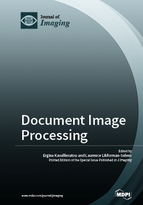Document Image Processing
A special issue of Journal of Imaging (ISSN 2313-433X).
Deadline for manuscript submissions: closed (15 December 2017) | Viewed by 95987
Special Issue Editors
Interests: document image; document image processing; historical document images; document analysis; deep learning; machine learning
Interests: handwriting recognition with Markovian methods (HMMs, Bayesian Networks) and Recurrent Neural Networks (BLSTMs); document analysis of historical documents; information extraction in degraded documents; Web documents; automatic detection of cognitive disorders from handwriting signal
Special Issue Information
Dear Colleagues,
Document Image Processing allows systems like OCR, writer identification, writer recognition, check processing, historical document processing, etc., to extract useful information from document images. In order to succeed, many preprocessing tasks can be required: Document skew detection and correction, slant removal, binarization and segmentation procedures, as well as other normalization tasks.
The intent of this Special Issue is to collect the experiences of leading scientists of the field, but also to be an assessment tool for people who are new to the world of document image processing.
This Special Issue intends to cover the following topics, but is not limited to them:
- Document Image Analysis
- Document Understanding
- Document Analysis Systems
- Document Processing
- Camera-based Document Processing
- Document Databases and Digital Libraries
- Mining Document Image Collections
- Document Forensics
- Historical Documents
- Segmentation and Restoration
- Performance Evaluation
- Camera and Scene Text Understanding
- Machine Learning for Document Analysis
- Human-Document Interaction
- Novel Applications
Indeed, any work concerning the use of document image processing, as well the development of new application procedures, may fall within the scope of this Special Issue. Of course, papers must present novel results, or the advancement of previously published data, and the matter should be dealt with scientific rigor.
Dr. Ergina Kavallieratou
Dr. Laurence Likforman
Guest Editors
Manuscript Submission Information
Manuscripts should be submitted online at www.mdpi.com by registering and logging in to this website. Once you are registered, click here to go to the submission form. Manuscripts can be submitted until the deadline. All submissions that pass pre-check are peer-reviewed. Accepted papers will be published continuously in the journal (as soon as accepted) and will be listed together on the special issue website. Research articles, review articles as well as short communications are invited. For planned papers, a title and short abstract (about 100 words) can be sent to the Editorial Office for announcement on this website.
Submitted manuscripts should not have been published previously, nor be under consideration for publication elsewhere (except conference proceedings papers). All manuscripts are thoroughly refereed through a single-blind peer-review process. A guide for authors and other relevant information for submission of manuscripts is available on the Instructions for Authors page. Journal of Imaging is an international peer-reviewed open access monthly journal published by MDPI.
Please visit the Instructions for Authors page before submitting a manuscript. The Article Processing Charge (APC) for publication in this open access journal is 1800 CHF (Swiss Francs). Submitted papers should be well formatted and use good English. Authors may use MDPI's English editing service prior to publication or during author revisions.
Keywords
- document image;
- document image processing;
- historical document images;
- document analysis;
- deep learning;
- machine learning;







